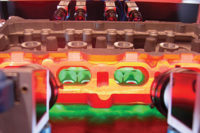A complex manufacturing world is requiring increasingly intricate solutions to address both quality and economic concerns. While the technical challenges posed can wander as far as our imaginations can take us, the problems posed during project execution are often common and avoidable. Unfortunately, these problems are all too common in manufacturing and automation, while practical approaches to avoid these pitfalls are not.
Manufacturers can profit and their automation can thrive by leaning on qualified machine vision integrators. The integrator is there to take their application all the way from the point of problem definition through to a functioning machine on the customer floor. If done strategically and with care, the customer will experience higher quality automation systems, access to the top engineers in their discipline, quicker results, and the elimination of risk of failure, and protection from out of control project costs.
Sounds pretty good, right? Here are the keys to integration success from my experiences along the way. Let’s take a look at how you can succeed every time.
No fear
A good integrator is there to take away your risk and usher you into, and through, the project stage by stage. After initial contact, usually by phone, an integrator can establish quickly if your application is technologically viable and collect their initial summary specification. At this initial marker, the integrator begins to collect data and build an assembly of important pieces of information that form the foundation of what could be a future custom machine vision project.
Write it down
Nothing makes an integrator happier than a good project specification. It should outline in clear terms many items including, but definitely not limited to, the problem to be solved, speed, environment, and the initial pass/fail requirements. Without this critical piece, or the willingness of a customer to participate in its generation, the integrator and potential customer should put things on hold until time when these details can be documented. Without them any pricing supplied by a less diligent supplier could result in costly change orders and term disagreements in time. All of the keys to success are for the benefit of both supplier and customer.
Show and tell
Most engineers are visual learners, and once proper nondisclosure agreements are signed, a true partnership can be cultivated. At this stage, a good integrator will ask a lot of questions. These should not be intended to overcomplicate or increase the scope of work for revenue gains. These discussions will either lead quickly to a mutual agreement that the solution is not feasible at the customer’s budget estimates, or agreements a fixed turnkey proposal will be worth generating in the near future. Any drawings, models, images, and videos should be shared freely as no information is too much at this phase.
Test Early
Your integrator should have the ability to quickly and competently use their development test lab to insure a proof of concept before either party commits to moving forward. Getting a variety of samples into the hands of an experienced vision integrator is sometimes all it takes to match your complex problem to an innovative technology you may have not considered. The results of the simulated testing can boost the confidence of both the customer and integrator by demonstrating the ability of lighting, lensing, machine vision devices, and software solutions. No one should have to enter into a large or small capital project without having the peace of mind that no matter the challenges to make a solution production capable, the unique imaging piece of the puzzle is no longer a worry. If the customer requires approval from other parties, these early results are often what can help ease the process of investing in new technology.
It’s OK to talk about it
You made it this far, this is not the time to drop the keys. Suddenly the integrator and customer both have exhausted time and effort, and often, one or both have invested significantly with no formal commitment. The integrator and customer should feel like partners as much proprietary information has been shared by now, and they both should be comfortable discussing honest budget numbers. There is no need for any wasted efforts at this time if it is clear there is no overlap in the customer goals and what the integrator can realistically deliver. On the bright side, if the opportunity for partnership was attempted openly and honestly, then there may come a time when changes make the project make sense, or another application at the facility develops.
Write It Down… Again
The case for the project’s viability has continued to grow and now the integrator has agreed to prepare the formal proposal. This document is a direct reflection of the diligence and depth of discussion so far. Now the integrator spends focused time detailing the concepts and hardware solutions agreed upon and creates a turnkey price that encompasses all costs associated with a true turnkey design, build, install, train, and support. This document should not only hold the information needed to secure remaining funding, and ultimately a customer PO, but also summarize all the technical and operational details of the solution to be built. Gaps in this document lead to tough discussions later of what was agreed to under the purchase. An experienced integrator will take you through the proposal documentation step by step and allow the customer to ask questions and identify any incorrect specification data or missing quantities. Don’t forget to discuss and add estimated lead time and estimated project start date; this can help both parties maintain an internal resource plan.
It’s a small world
There will never be an equal substitute for meeting face to face. This is, at some point, essential to projects as involved as these. The greatest of today’s integrators leverage technology to stay in connection with their clients throughout the process. If remote communication, maintenance, monitoring, and troubleshooting capabilities are established before the machine is built, the customer can expect great things. This often challenging, and approval requiring, IT exercise consistently results in dramatically faster turnaround when the time comes for troubleshooting on site. This function carries through to production startup and beyond into the life of the machine. Thoughtful care here is important as nonessential travel expenses have the potential of killing a project before it gets off the ground, or souring it later.
Solutions, Not Sales
For quite a few years, I have been categorized as a “sales” engineer, but as an engineer and integrator, the process of focusing on these steps eliminates typical sales processes concentrated solely on the close of a deal. In my experience, the projects that followed these steps have resulted in a 100% success rate for everyone involved. The goal is not the sale; the goal is primarily one of two outcomes. The first might end with an efficient and amicable conclusion that the current project is not viable with the prospect of future exploration. The alternative is all the steps are used without exception and the project concludes with resounding success. The fundamentals not only create happy customers, but true partnerships for years to come.
Concluding thoughts
From my vantage point, the growth of automation, and in particular the machine vision industry, is exploding into every conceivable market. Robots, 2D, 3D, software, and machine learning are all firmly established into our daily lives and the production and distribution of our goods. This is creating a nearly infinite new host of applications previously stuck in the not viable column. With new technologies also come many challenges. A trusted integrator considers of equal importance the customer concerns of reliability and security of these new and potentially but avoidably risky investments.
As an integrator, each project builds unto the next and there will be more keys to find. Through collaboration and creativity in the spirit of mutual benefit, everyone can reap the rewards of quality automation.





